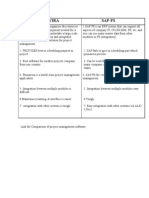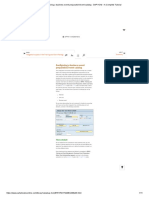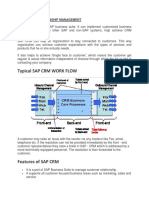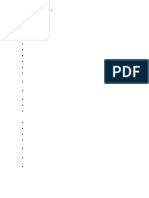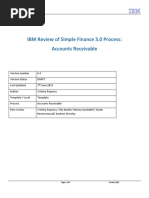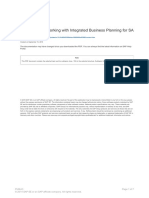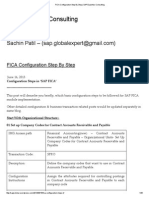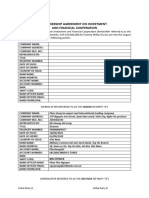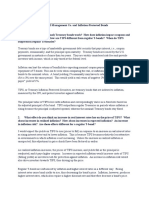SAP Return On Investment
SAP Return On Investment
Uploaded by
srinivaspanchakarlaCopyright:
Available Formats
SAP Return On Investment
SAP Return On Investment
Uploaded by
srinivaspanchakarlaOriginal Title
Copyright
Available Formats
Share this document
Did you find this document useful?
Is this content inappropriate?
Copyright:
Available Formats
SAP Return On Investment
SAP Return On Investment
Uploaded by
srinivaspanchakarlaCopyright:
Available Formats
SAP Return on Investment
1 MSS SAP BEST PRACTICE
Overview on ROI (Return on Investment) From SAP
Introduction Return on Investments (ROI) Estimation is very tricky in the case of SAP Projects. More so in the case when an ERP system becomes the entire Foundational Backbone of an organization's functioning. Something very interesting facts about ROI Significant increase in ROI can be achieved if the software application is appropriate to the needs of the organization. In the long term, an application that is flexible, and can adapt to changing business requirement, will reduce the cost of change and increase the ROI" Once SAP has been implemented there is a stabilization phase, which typically lasts between six months and a year. After that, organizations will try to calculate ROI in definite terms. But many are not able to quantify ROI on ERP for certain reasons Today the main challenge is the organizations are not able to quantify their ROI from ERP implementation because at the beginning of the project the KPI (Key performance indicators) and measurement criteria not defined. Some SAP Clients fail to realize the ROI as they think about it only after implementing ERP. There are certain business metrics that need to be considered well in advance. This could be inventory levels, number of days for customer outstanding, the type of reports, the number of people in a particular function etc, For instance if out standings were X number of days, we planned to reduce it by 50 percent within two years. This can be done with SAP. SAP implementation changes the existing business processes in favor of ones that are streamlined to the best ones followed in the industry. It changes the way business is done. The work profile at the end user level also changes. The productivity gains resulting both from improved processes and integration of financial, business and transaction data are huge
The best thing to do is to identify the objective or purpose of ERP before implementation or rollout, and then compare the achieved benefits to those desired When do you start with SAP Return on Investment or SAP ROI? SAP Implementation is an Investment not just event. How much is it going to cost and how long is it going to take? That is the classic approach to SAP implementations. Today its not enough and the marketplace is demanding more from their IT dollars. Now there are questions about measuring cost reductions, process improvements. Before SAP Implementation start it is good idea to know following current legacy systems cost, You know what your man hours are (staffing, personnel, benefits, overhead, etc., etc., etc.), process cycle times, per transaction costs for things like purchase orders, sales orders, production orders, etc., competitor transaction cost benchmarks, current application license and maintenance costs, Inventory levels etc., etc., etc.
2 MSS SAP BEST PRACTICE
ROI can be measureable? Tangible and Intangible benefits from SAP Tangible benefits: Improves the productivity of process and personnel Lowering the cost of products and services purchased Paper and postage cost reductions Inventory reduction Lead time reduction Reduced stock obsolescence Faster product / service look-up and ordering saving time and money Automated ordering and payment, lowering payment processing and paper costs
Intangible benefits: Increases organizational transparency and responsibility Accurate and faster access to data for timely decisions Can reach more vendors, producing more competitive bids ; Improved customer response Saves enormous time and effort in data entry ; More controls thereby lowering the risk of mis-utilization of resources Facilitates strategic planning Uniform reporting according to global standards
Calculation of ROI There is no standard method of calculation of ROI for an ERP project but a structured method of analysis is achievable. It may be too cumbersome and subjective to factor in intangible benefits. But these factors are important for creating an overall business case and in many instances, where ROI is not calculated, form a base line objective for the project. First step is to determine cost of various components of the project such as consulting fees license fees, modification and implementation cost, hardware cost etc. Maintenance fees for a pre determined period (say for three or five years) should be added to arrive at Total Cost of Ownership over the specified period. The estimated expenditure should be time phased over the period, used to calculate TCO. Next step is the more difficult part which is to estimate expected benefits over a period of time. For estimating these figures, there should be wide consultation and reference to statistics emanating from various survey reports. Benefits will largely occur from the reduction of inventory level, operation cost, labor cost and improved production. Whereas the last three elements will have a direct impact on profit and loss account, the
3 MSS SAP BEST PRACTICE
reduction in inventory will cause release of additional cash which can be assigned to a yearly value of saving, based on organizations standard internal rate of return. Relationship between time phased cost and benefit will project a time phased ROI, which will be negative at the outset and will turn positive over the payback period.
Framework of Tangible benefits
Dimensions Operational
Sub dimensions Cost reduction Cycle time reduction Productivity improvement Customer service Improvement Better resource Management Improve Decision making and Planning Performance Improvement Support business growth Generate product differentiation IT cost reduction IT cost reduction Support organizational Changes Build common visions
Managerial
Strategic
IT Infrastructure Organizational
Tangible Quantifiable Yes Yes Yes Yes Yes Yes Yes Yes Yes Yes Yes Yes Yes Yes Yes Yes Yes Yes Yes Yes Yes Yes Low Low Low Low
Key Challenges in achievement of Positive ROI from SAP Lack of breadth and repeatability High personnel costs Excessive customization
To accelerate ROI the scope of their deployment, limited customization of the solution, and ensured broad user adoption.
Conclusion: There is no standard method of measuring the ROI however It is possible to measure ROI from SAP Implementation to some extent if we have current system figures. We have Information systems benefits have been classified with respect to several frameworks: tangible Vs quantitative.
4 MSS SAP BEST PRACTICE
SAP Cost/Benefit Analysis
FI/CO Modules Reduce Receivables (0-75%, 20%): Calculation Identify current working capital investment in receivables Determine average days outstanding Estimate reduction in days outstanding Determine associated reduction in working capital Benefit (annual) is the cost of capital for the reduction in working capital SAP Enablers On-line and integrated system provides faster invoicing cycle time Better analysis tools for receivables analysis Reduce Lost Discounts (0-90%, 40%): Calculation Identify dollar volume of purchases with discounts Identify % discounts taken Estimate % increase in discounts taken Estimate average discount (usually 1 to 2 %) and associated payable age reduction Multiply % increase in discounts taken times dollar volume of purchases with discounts Multiply increased purchase volume subject to discount just calculated by the average discount Subtract off cost of capital for required increase in working capital (estimating increase in working capital in this case is somewhat complex. Find someone who knows how to estimate the increase in working capital) SAP Enablers Integration with purchasing provides on-line verification and reduced entry Improved availability of information to pay invoice resulting in quicker payment
Reduce Credit Losses (0-50%, 5%) Calculation Identify annual credit write-off Estimate percent reduction SAP Enablers Credit Management integrated with sales and distribution functionality Improve Cost Control - Reduce Costs (0-4%, 2%) Calculation Identify budget accounts and amounts for the organization Review budget accounts and determine which accounts are controllable Calculate total dollars in controllable accounts Estimate percent reduction in controllable costs
5 MSS SAP BEST PRACTICE
SAP Enablers On-line, Real-time cost management information On-line analysis tools Earlier visibility of costs and commitments SD Module Improve Pricing (0-10%, 1%) Calculation Identify total sales by product line in dollars Estimate % improvement in pricing Since improved pricing does not materially impact fixed or variable costs, benefit is sales multiplied by improvement percentage SAP Enablers On-line real-time capabilities increase responsiveness and customer service Pricing procedures capability helps reduce bad deals On-line visibility of product cost and profitability analysis enables better decisions Increase Sales (0-10%, 2%) Calculation Identify sales volume by product line Estimate total sales capacity/production capacity (this should include allowances for preventative and unplanned downtime for maintenance reasons) Estimate sales value of lost available production Estimate margin of lost production Estimate portion of capacity that can be converted to sales SAP Enablers On-line real-time capabilities increase responsiveness and customer service Improved customer forecasting
MM Module Reduce Inventory (0-50%, 10%) Calculation Identify inventory value by category (if LIFO valuation, value is actually higher than reported) Estimate inventory reduction goals by category One approach would be to treat reduction as a one-time benefit, but Another approach would be to recognize the annual benefit of reduction in carrying costs (I believe this better reflects reality) Multiply inventory reductions by incremental carrying costs (Carrying cost includes cost of capital, taxes, insurance, and damage allowances - should not include cost of assets, labor, or building unless major reductions in inventory are anticipated) SAP Enablers Improved visibility of inventory Improved forecasting Improved data accuracy
6 MSS SAP BEST PRACTICE
Reduced process cycle times Reduce Landed Costs (0-10%, 4%) Landed costs includes all costs associated with getting a product or service available for use. Landed cost will therefore include purchase, freight, receiving, quality, return, and vendor management costs. Calculation Since purchasing cost is far and away the largest component of landed costs, identifying current annual purchasing dollars is a good conservative estimate of landed costs. Estimate percent reduction in landed costs with SAP. Factors to consider include How much EDI is currently used Is purchasing transaction oriented or vendor management oriented ? How good of history does current systems provide? How much vendor, requisition consolidation opportunity exists ? Do current systems provide vendor evaluation tools?
Determine savings by multiplying purchase volume by estimated % reduction SAP Enablers On-line, integrated systems reduce transaction effort to enable more focus on vendor relationship management On-line history provides information to negotiate better agreements On-line availability of information helps drive consolidation of purchases with partnership vendors Vendor evaluation tools help manage vendor quality and shipment problems Reduce Obsolescence and Damage (0-10%, 2%) Calculation Identify current inventory obsolescence and damage costs Estimate improvement SAP Enablers SAP provides on-line visibility of stock usage PP Module Increase Production/Sales (0-5%, 1%) Calculation Determine total sales Determine margin on sales Determine capacity utilization Estimate increase in capacity utilization Benefit is the margin on additional production SAP Enablers Integration with MM provides earlier visibility of material/asset availability issues Production planning helps identify unused capacity Better forecasting and planning tools helps identify correct product mix to produce Better planning tools help manage product conversion (tear down, setup, off-spec) costs
7 MSS SAP BEST PRACTICE
Reduce WIP Inventory (0-50%, 10%) Calculation Identify value of WIP inventory Estimate percent reduction in WIP Multiply inventory reductions by incremental carrying costs (Carrying cost should include cost of capital, taxes, insurance, and damage allowances - should not include costs for assets, labour, or building unless major reductions in inventory are anticipated) SAP Enablers Better forecasting and planning tools minimize need to maintain WIP as a buffer against unknown demand Improved visibility of inventory with on-line system Improved accuracy of inventory information Improve Margins (0-5%, 2%) Calculation Identify sales by product line Determine margin by product line Estimate improvement percentage Apply improvement to total sales volume SAP Enablers Profitability analysis helps target product mixes for greater profitability Product costing helps target changes in production and pricing strategy PM Module Increase Asset Utilization - Reduce Production Asset Downtime (0-10%, 5%) Calculation Identify daily sales volume Determine margin on daily sales Determine fixed cost per day Determine production downtime for planned and unplanned maintenance Estimate portion of downtime to be eliminated Benefit is margin and fixed costs previously lost during downtime SAP Enablers Integration with other modules reduces cycle time for maintenance orders On-line system with analysis tools helps drive down unplanned maintenance Better problem tracking and preventative maintenance forecasting Reduce Maintenance Requirements (0-10%, 4%) Calculation Estimate total cost of plant maintenance - usually captured in a cost center Estimate reduction in maintenance due to improved preventative maintenance SAP Enablers Preventative maintenance capability Maintenance history reporting and analysis Other Benefit Areas
8 MSS SAP BEST PRACTICE
Existing Systems Infrastructure Eliminate Mainframe and Other Equipment (100%) Identify hardware to be eliminated Estimate salvage value (or lease cost) of hardware Eliminate Maintenance Contracts For Current Hardware and Software to be Eliminated (100%) Identify hardware and software to be eliminated Identify maintenance contracts on hardware/software to be eliminated Reduce IT staff required to support current hardware and software (0-100%, 75%) Identify total FTEs supporting existing hardware and software Allocate FTEs to current hardware maintenance, software systems and overhead processes Determine FTEs allocated to maintenance of hardware and software to be eliminated Year 2000 Cost Avoidance By now, this is probably no longer a viable savings area. However, the IT department has probably estimated the cost of year 2000 problem. Other Project Avoidance (100%) Identify planned projects to develop point solutions (i.e. Plant Maintenance package) that will no longer be required when SAP is installed Determine planned budget for all planned projects
Manpower Reductions (0-20%, 10%)
Identify processes performed in all departments impacted by SAP implementation
Identify characteristics of each process identified above (i.e. frequent rework, excessive downtime, missing information) Identify key ways that SAP will change each of the processes identified Estimate the percent change in manpower effort required for each process Determine net change in manpower by department and by position Determine where opportunities exist to reduce manpower Multiply reductions by manpower cost loaded with benefits only.
9 MSS SAP BEST PRACTICE
You might also like
- S4f95.20.en-Us 1Document1 pageS4f95.20.en-Us 1samirkumar s4sahoo0% (1)
- Industry Study Activities Industrial Technology HSCDocument3 pagesIndustry Study Activities Industrial Technology HSCapi-320830582100% (1)
- Prapanna Ray SAP PSDocument4 pagesPrapanna Ray SAP PSprapanna rayNo ratings yet
- Primavera Vs SAP PSDocument1 pagePrimavera Vs SAP PSHarishKumar100% (1)
- Hoshin Kanri - Visual Strategic Planning Student WorkbookDocument90 pagesHoshin Kanri - Visual Strategic Planning Student WorkbookbernardoNo ratings yet
- C - TPLM50 - 95 - SAP Certified Application Associate - Portfolio and Project Management 5Document7 pagesC - TPLM50 - 95 - SAP Certified Application Associate - Portfolio and Project Management 5ongkecanthoNo ratings yet
- Overview of Enhancements in SAP Revenue Accounting and Reporting 1.1Document15 pagesOverview of Enhancements in SAP Revenue Accounting and Reporting 1.1April Mosca-ReyesNo ratings yet
- Real Estate: WarningDocument12 pagesReal Estate: WarningmkvadlamudiNo ratings yet
- Pradeep PS & MM - 1101Document5 pagesPradeep PS & MM - 1101Pradeep GuptaNo ratings yet
- Strategic Aspects of Retrofit: Or: What Do I Need To Think About?Document4 pagesStrategic Aspects of Retrofit: Or: What Do I Need To Think About?pankajssharmaNo ratings yet
- SAP PPM Maintain Projects Contents PDFDocument23 pagesSAP PPM Maintain Projects Contents PDFRaghu SharmaNo ratings yet
- Op Guide Sap S/4hanaDocument30 pagesOp Guide Sap S/4hanaPijush BiswasNo ratings yet
- SAP Fiori TutorialDocument1 pageSAP Fiori Tutorialganga bhavaniNo ratings yet
- Business Process in SAP CPM For CostingDocument8 pagesBusiness Process in SAP CPM For Costingjkak2022No ratings yet
- EN - PS - WBS ElementDocument22 pagesEN - PS - WBS ElementGhosh2No ratings yet
- Project Management With SAP R3Document98 pagesProject Management With SAP R3pepino2011No ratings yet
- Ifrs at Sap: Transition To IFRS: Implementation of IFRS As An Additional Set of Accounting Standards Alongside US GAAPDocument29 pagesIfrs at Sap: Transition To IFRS: Implementation of IFRS As An Additional Set of Accounting Standards Alongside US GAAPlsudhakarNo ratings yet
- Configuring A Business Event Preparation - Event Catalog - SAP HCM - A Complete TutorialDocument11 pagesConfiguring A Business Event Preparation - Event Catalog - SAP HCM - A Complete TutorialMomInul HoQueNo ratings yet
- Typical Sap CRM Work Flow: Customer Relationship ManagementDocument9 pagesTypical Sap CRM Work Flow: Customer Relationship ManagementnyalitamNo ratings yet
- SAP Japan Customer Innovation Center Solutions August 9th, 2010Document90 pagesSAP Japan Customer Innovation Center Solutions August 9th, 2010Taro Yamada100% (1)
- DISC ACT100 EN Col05Document96 pagesDISC ACT100 EN Col05jose100% (1)
- Introduction To Rapid Financial Planning & Analysis For SAP S4HANA Using SAP Analytics CloudDocument46 pagesIntroduction To Rapid Financial Planning & Analysis For SAP S4HANA Using SAP Analytics CloudgfraoterNo ratings yet
- Contract Allocation - Stand Alone Selling PriceDocument19 pagesContract Allocation - Stand Alone Selling Pricenagalakshmi100% (1)
- SAP PS - Project Profile 10Document4 pagesSAP PS - Project Profile 10tarini acharyaNo ratings yet
- S4F23Document229 pagesS4F23Aurora Da CunhaNo ratings yet
- Accenture Implementing SAP Intercompany Billing Drives High PerformanceDocument2 pagesAccenture Implementing SAP Intercompany Billing Drives High PerformanceBharat LimayeNo ratings yet
- S4HANA OP 1511 Learning Journey BetaDocument9 pagesS4HANA OP 1511 Learning Journey BetaJorge Santillan0% (1)
- SAP Internet SalesDocument34 pagesSAP Internet Salesmanindra_tiwariNo ratings yet
- SAP ByDesignDocument30 pagesSAP ByDesignHong YangNo ratings yet
- Sap CPM 2Document4 pagesSap CPM 2RaghavendraMuruganNo ratings yet
- Sap Re PDFDocument66 pagesSap Re PDFimco74No ratings yet
- AC206 Parallel Valuation and Financial Reporting: Local Law - IAS (IFRS) / US-GAAP?Document6 pagesAC206 Parallel Valuation and Financial Reporting: Local Law - IAS (IFRS) / US-GAAP?mhku1No ratings yet
- Chakravarthy - SAP PPM & CPMDocument15 pagesChakravarthy - SAP PPM & CPMyashswi kaushikNo ratings yet
- Ricefw or Wricef in Sap ProjectDocument11 pagesRicefw or Wricef in Sap ProjectGilvanildo AlmeidaNo ratings yet
- Exp 0009Document39 pagesExp 0009tushar2001No ratings yet
- Step by Step Guide To Create One-Time Business Partner Customer - Vendor in SAP S - 4HANA - SAP Tips and Tricks From High Skilled Experts - SAP BlogsDocument7 pagesStep by Step Guide To Create One-Time Business Partner Customer - Vendor in SAP S - 4HANA - SAP Tips and Tricks From High Skilled Experts - SAP BlogsSHIH CHUNG HUNGNo ratings yet
- IBM Review of Simple Finance 3.0 Process: Accounts ReceivableDocument9 pagesIBM Review of Simple Finance 3.0 Process: Accounts ReceivableMOORTHYNo ratings yet
- SAP Fiori Whitepaper - New PDFDocument17 pagesSAP Fiori Whitepaper - New PDFKrishna Moorthy KNo ratings yet
- S4F90 - SAP Business Planning and Consolidation Embedded Consolidation SAP TrainingDocument6 pagesS4F90 - SAP Business Planning and Consolidation Embedded Consolidation SAP TrainingsapbpcNo ratings yet
- 10.27.2022 SNP Presentation - ASUG MN - How To Simplify The S4HANA Journey Through Selective Data Migration and Management OptionsDocument18 pages10.27.2022 SNP Presentation - ASUG MN - How To Simplify The S4HANA Journey Through Selective Data Migration and Management OptionsP177264No ratings yet
- POC All Costs Scenario ScriptsDocument41 pagesPOC All Costs Scenario ScriptsnagalakshmiNo ratings yet
- Business Partner SAP S - 4 HANA Insights - SAP CommunityDocument14 pagesBusiness Partner SAP S - 4 HANA Insights - SAP Communitychalapathi2002No ratings yet
- Joule L0Document12 pagesJoule L0matheusdetoniabapNo ratings yet
- SAP S4HANA 2023 Finance Module Enhancements SummaryDocument2 pagesSAP S4HANA 2023 Finance Module Enhancements Summarycamef84672No ratings yet
- IPS910 TemarioDocument21 pagesIPS910 TemarioAdrian EspinosaNo ratings yet
- Project Systems Structure OverviewDocument33 pagesProject Systems Structure OverviewPNo ratings yet
- FI - Customizing SAPDocument9 pagesFI - Customizing SAPAnanthakumar ANo ratings yet
- Sarath Babu ResumeDocument7 pagesSarath Babu ResumeRohit LalwaniNo ratings yet
- Configuration of CFIN Inbound Interfaces 1Document41 pagesConfiguration of CFIN Inbound Interfaces 1rajan karkiNo ratings yet
- Case Study Cherrytec Goods Services Tax (GST) in SAPDocument2 pagesCase Study Cherrytec Goods Services Tax (GST) in SAPSuresh RNo ratings yet
- SAP Simple Finance IBP Steps For Working With IBPDocument7 pagesSAP Simple Finance IBP Steps For Working With IBPmrudrabhNo ratings yet
- Profit Center AccountingDocument11 pagesProfit Center AccountingManish bhasinNo ratings yet
- Fakhar Abbas Ansari: Sap Fi-Fm - Consultant Sap IdDocument5 pagesFakhar Abbas Ansari: Sap Fi-Fm - Consultant Sap IdFakhar Abbas AnsariNo ratings yet
- Houghton Mifflin Harcourt Sap Document of UnderstandingDocument10 pagesHoughton Mifflin Harcourt Sap Document of UnderstandingSunil KumarNo ratings yet
- SAP PS Project Usual QuestionsDocument2 pagesSAP PS Project Usual Questionsjenfil82No ratings yet
- Sudhakar P - 13 Yrs - SAP FICO-S4 HANA FIN - Data Migration LeadDocument6 pagesSudhakar P - 13 Yrs - SAP FICO-S4 HANA FIN - Data Migration Leadsudhakar P100% (1)
- SAP S4 HANA Online TrainingDocument5 pagesSAP S4 HANA Online TrainingGloryittechnologies100% (1)
- Manage Your SAP Projects with SAP Activate: Implementing SAP S/4HANAFrom EverandManage Your SAP Projects with SAP Activate: Implementing SAP S/4HANANo ratings yet
- Uk Driving License DocumentDocument2 pagesUk Driving License DocumentsrinivaspanchakarlaNo ratings yet
- Real Estate Lifecycle Management PDFDocument24 pagesReal Estate Lifecycle Management PDFsrinivaspanchakarlaNo ratings yet
- FICA Configuration Step by Step - SAP Expertise Consulting PDFDocument35 pagesFICA Configuration Step by Step - SAP Expertise Consulting PDFsrinivaspanchakarla50% (6)
- FI - CO - MM - SD Integration PDFDocument23 pagesFI - CO - MM - SD Integration PDFsrinivaspanchakarlaNo ratings yet
- Statement of WorkDocument3 pagesStatement of Worksrinivaspanchakarla100% (1)
- Service Tax Recovery CircularDocument9 pagesService Tax Recovery CircularsrinivaspanchakarlaNo ratings yet
- Special Purpose Ledger ConfigDocument81 pagesSpecial Purpose Ledger Configsrinivaspanchakarla75% (4)
- Manual BRS ConfigDocument23 pagesManual BRS Configsrinivaspanchakarla100% (1)
- SKP Sec-Balrampur (Init Cov) - 2012Document12 pagesSKP Sec-Balrampur (Init Cov) - 2012rchawdhry123No ratings yet
- Class 11 Indian Economic Development - Chapter 10Document10 pagesClass 11 Indian Economic Development - Chapter 10SheaNo ratings yet
- DOA GPI 20millionDocument18 pagesDOA GPI 20millionMinh KentNo ratings yet
- UntitledDocument83 pagesUntitledNeeraj MishraNo ratings yet
- Cambridge International AS & A Level: BUSINESS 9609/31Document4 pagesCambridge International AS & A Level: BUSINESS 9609/31OSHADA AKALANKA 11-BNo ratings yet
- Cost Acc Chapter 12Document8 pagesCost Acc Chapter 12ElleNo ratings yet
- Financial IntelligenceDocument198 pagesFinancial IntelligenceBohdan MalaniukNo ratings yet
- Managerial Accounting (Chapter 1)Document31 pagesManagerial Accounting (Chapter 1)ap0075No ratings yet
- Gonzales - Week 2 1Document10 pagesGonzales - Week 2 1Luigi Enderez BalucanNo ratings yet
- ch13 Salvatore PPPDocument36 pagesch13 Salvatore PPPAngelieTongNo ratings yet
- Business Law Chapter-4 (1) ... State Owned Economic PDFDocument18 pagesBusiness Law Chapter-4 (1) ... State Owned Economic PDFmmcities100% (4)
- The Effect of Suez Canal Blockage On Supply ChainsDocument37 pagesThe Effect of Suez Canal Blockage On Supply ChainsNGUYEN TRUONG SONNo ratings yet
- T Shape Account PreprationDocument5 pagesT Shape Account Preprationrajindere sainiNo ratings yet
- Brazil: Dancing Through The Economic CrisisDocument4 pagesBrazil: Dancing Through The Economic CrisislucompanNo ratings yet
- Green Modern Financial Management PresentationDocument18 pagesGreen Modern Financial Management PresentationCheesca Macabanti - 12 Euclid-Digital ModularNo ratings yet
- Practice Quiz - Review of Working CapitalDocument9 pagesPractice Quiz - Review of Working Capitalcharisse nuevaNo ratings yet
- Grade 6 NAT Scores in Filipino and Science Were Below The National Passing Rate of 75%Document3 pagesGrade 6 NAT Scores in Filipino and Science Were Below The National Passing Rate of 75%Nenbon NatividadNo ratings yet
- Servive Marketing Assignment On Banyan Tree: Designing and Delivering A Branded Service ExperienceDocument6 pagesServive Marketing Assignment On Banyan Tree: Designing and Delivering A Branded Service ExperienceTejveer SinghNo ratings yet
- Legal Documents Needed by A Grocery StoreDocument2 pagesLegal Documents Needed by A Grocery StoreSteinol SolutionsNo ratings yet
- 3rd Year BusCom Intercompany TransactionsDocument2 pages3rd Year BusCom Intercompany TransactionsJoshua UmaliNo ratings yet
- FINANCIAL STATEMENT For PrintDocument4 pagesFINANCIAL STATEMENT For PrintGkgolam KibriaNo ratings yet
- Written ReportDocument6 pagesWritten ReportElennel MadriagaNo ratings yet
- CaseheroDocument5 pagesCaseheroJoe MoretNo ratings yet
- Closing Entries ExercisesDocument2 pagesClosing Entries ExercisesRodolfo CorpuzNo ratings yet
- Macrame BasketryDocument6 pagesMacrame BasketryYssah Rabano BentijabaNo ratings yet
- Financial Manual PDFDocument71 pagesFinancial Manual PDFhimanshuNo ratings yet
- MDRRMC Resolution Canaman Revised - 11 02 22Document5 pagesMDRRMC Resolution Canaman Revised - 11 02 22Mara Kenia BarcelonNo ratings yet
- Progress2CSc 151Document7 pagesProgress2CSc 151Jonbert AndamNo ratings yet




